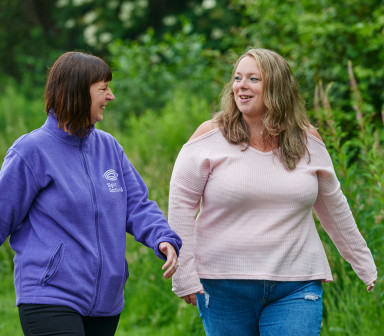Mobility canes are a form of mobility aid that enable blind or visually impaired people to go about their daily business when out and about, especially in unfamiliar areas.
White mobility canes are used by many people who have a visual impairment. Primarily, they aid a person to scan their surroundings for obstacles or find orientation clues. They are also helpful for others such as road users in identifying the person as vision impaired so that they can take appropriate care and attention.
Mobility canes are often made from aluminium, graphite-reinforced plastic or other fibre-reinforced plastic, and can come with a wide variety of tips depending on the user’s preference. They can be either collapsible or straight.
Here are the most common types of canes you may come across.

Types of Cane
Symbol cane
These canes are smaller than other types of mobility cane. They are a signifier and are used primarily to make others aware of the user’s vision impairment. For example, it may alert drivers that a pedestrian holding one may not be able to see them, and as such to take extra care.
A symbol cane is often lighter and shorter than the long cane, and can be folded up to fit into a bag or pocket when not in use. It has no real use as a mobility tool. Some people with a visual impairment use the symbol cane to check for a stair edge or kerb edge and it can be used to detect things like door edges and frames.
Guide cane
This type of cane is longer than a symbol cane and is used for basic protection. A guide cane generally extends from the floor to the user's waist, providing information about surroundings around a step ahead. It can be used to scan for kerbs and steps. The guide cane can also be used diagonally across the body for protection, warning the user of obstacles immediately ahead. A roller tip can be used if appropriate to aid travel in different situations, especially in unfamiliar areas and where surface underfoot is uneven. The guide cane is also collapsible. It is advisable to have training from a rehabilitation officer to ensure correct use and ensure safety.
Long cane
This white cane is designed primarily as a mobility tool that is used to detect objects and provide information about the environment to the user about two steps ahead of them. The cane’s length depends on the user’s height, and traditionally extends from
the floor to the user's sternum. It differs from the guide cane in that a long cane’s end has a tip of some kind – either rolling or pointed.
Rolling tips can be best for smooth pavements and offer the largest amount of protection as they never leave the ground. They can be either cricket ball shaped, or more cylindrical. Pointed tips can be used when tapping the ground as opposed to rolling across it. Your rehabilitation officer will advise you on the correct tip for different situations. It is recommended that long cane training be undertaken with a qualified rehabilitation officer.
Support cane
The white support cane is designed primarily to offer physical support and stability to someone who is blind or partially sighted. Its white colour means the cane also works to make others aware the user has sight loss. White support canes need to be measured so that the height is correct for the individual. Support canes come with various styles of handles and can also be collapsible. It is recommended that individuals should be assessed by a physiotherapist to ensure correct height and use of support cane.
Red-striped canes
If you see any of the above white canes, including white support sticks, that also have red stripes on them, then this signifies that the person also has a hearing impairment as well as a visual impairment.
Cane and mobility training
Training in the use of canes with a qualified rehabilitation officer is always advised to make sure the person is using the cane correctly and, very importantly, safely when travelling.
Your local sensory impairment team will be able to advise and assess on selecting the right cane or canes for you and professional training.
Our rehabilitation officers work on a one-to-one basis with veterans with sight loss to discuss and identify which canes would be suitable for their needs, and can provide them with training too. If you know know someone with sight loss who you think could be eligible for our free support, please get in touch with us today.


